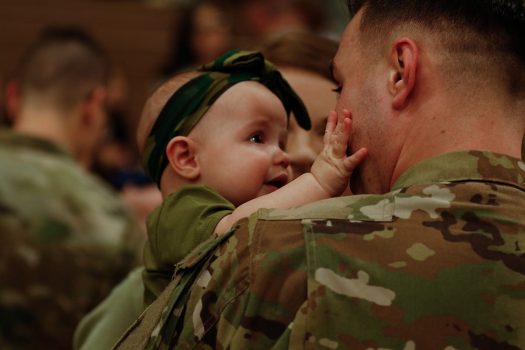Parenting responsibilities are a lot like learning a dance routine. Each new day there are rewards and challenges. Parenting requires extreme patience and flexibility. It is a journey full of opportunities for growth that are highlighted regularly. Some days you get to dance like nobody is watching and other days you must take everything in stride.
This is even more true for military service members and veterans who juggle their military responsibilities along with parenting responsibilities. Compounded with common parenting responsibilities, service members, and their families experience added stressors such as deployments, frequent moves, family transitions, and mental health issues. As we consider the ways that military and parenting responsibilities intersect, we also punctuate the impact of these life experiences on the mental health of the entire family system.
How can we support military families living with PTSD?
One of the first ways we come to understand PTSD is by identifying the symptoms experienced by the service member and their families. This news article in Today illustrates some examples of the day-to-day experiences of PTSD symptoms and their responses within a military family unit. Once we have identified the ways in which PTSD lives and breathes within a family system, we can notice and note opportunities for things to change. The article sheds light on examples of treatment options including destigmatizing PTSD, Cognitive Behavioral Therapy (CBT), and working with a therapist who specializes in PTSD treatment. It is through this process of incorporating the whole family into the discussion that we really notice how PTSD makes sense in context and where our support may be useful.
Talking with Kids about PTSD
For some military families, it can be helpful to incorporate kids into the conversation. The Mental Illness Research Education and Clinical Center (MIRECC), housed within the U.S. Dept. of Veterans Affairs, shares lots of great resources for the needs of military service members, veterans, and their families. Included in their resources is a guide for talking with kids about PTSD. The booklet helps parents to consider the positive and negative aspects of talking with children about PTSD. This includes:
- Deciding if/when the conversation should take place
- How to prepare for and begin the conversation
- How much to share or how specific to be
- How best to answer questions that kids might have
Because we know that PTSD affects everyone in the family, these family discussions can build connections and understanding. The guide also talks about balancing the amount of information shared. For example, military parents don’t have to talk about specific details of traumatic events to convey how they are doing now. Reliving the trauma can be even more harmful, but it is possible to talk about how those past events impact them right now.
When working with military families, we know that there is no “one size fits all.” This guide is a jumping-off point and gives parents several things to contemplate and tips for moving forward as they consider bringing kids into the conversation. One thing that the booklet does well is building on the strengths of the parent/child bond and meeting each kid, and parent, exactly where they are.
OneOp Resilience Series
To help military families build resilience around PTSD and other issues faced by individuals, families, and their greater communities, head over to the OneOp Resilience Series, a three-part webinar series cultivating individual, family, and community resilience.
References
Holohan, M. (2019). Veterans with PTSD struggle to parent, but help is available. Today Parents. Retrieved from: https://www.today.com/series/veterans/veterans-ptsd-struggle-parent-help-available-t165975
Sherman, M., Straits-Troster, K., Larsen, J., & Gress-Smith, J. (2015). A Veteran’s Guide to Talking with Kids about PTSD. South Central MIRECC. Retrieved from: https://www.mirecc.va.gov/VISN16/docs/Talking_with_Kids_about_PTSD.pdf
Blog Post Image: US Army [Homecoming by Sgt. Daphney Black, March 9, 2019, CC0]















